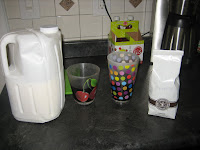Pandemic eating: How sweet it is
Several
times in the last month, I have acted on an uber-aggressive instinct to buy and
hoard comfort foods. In fact, every time I’ve forayed out to the market, decked
out in nitrile gloves and a blue-and-white mask, my first thought, after toilet
paper, has been sweets---cinnamon buns, black & whites, babka, banana bread
mix, shortbread cookies, and the list goes on.
I’ve gone
from coffee and toast in the morning, a salad for lunch, and a basic dinner
(often courtesy of Chipotle when working late) to a new routine---breakfast,
followed by a piece of chocolate from that fancy box I bought on Amazon and
stashed in the pantry, followed by Black Forest gummy bears or mandarin-flavored
Hi-Chews, and then maybe a little bit of romaine with dressing (me attempting
to inject some nutritional virtue into my day), and finally more sweets.
 |
| Melitta Bentz, early 1900's |
Turns out
I’m in good company (Facebook feed and all). In fact, it’s a foregone
conclusion that eating in quarantine means consuming more sugar and more carbs,
because they make you feel better and lift you up. It’s like eating love. Some
data shared and analyzed by Hustle showed that people are baking bread at
“unprecedented” levels---and this is borne out by empty shelves in the baking
section at supermarkets and an outsized interest in bread-baking machines and
sourdough starter kits.
Within the
last month, people have searched for flour on Amazon at a 3600% increased rate
compared with the previous month. Searches for yeast have increased by 3000%.
The main reasons that Hustle cites are comfort, stress relief, self-reliance, low
cost, store avoidance, and boredom. Notice that ‘comfort’ tops the list. And if
you’re into store-bought pastries, those too have seen an upsurge in popularity---an
18% increase in sales in the first week of March, according to Nielsen data
reported by Bloomberg.
Drinking
coffee goes well with eating sweets, not only because they complement each
other, but because coffee helps your body process sugar better. In fact,
coffee is associated with a significantly reduced risk of type 2 diabetes. In a
meta-analysis of almost 1 million people, drinking 3 to 4 cups of coffee a day
was associated with a 25% decreased risk of developing diabetes—even when
people were consuming sweets.
Right now,
I’m brewing and drinking Melitta Premium coffee, a brand that boasts that it uses
the highest quality arabica beans (within the top 2%). It’s good---I especially
like that it’s finely ground. It brews nicely with a paper filter. Strong,
bold, dark, and best served hot.
Did you
know, by the way, that Melitta is a brand that is named after a woman? Melitta
Bentz was a German house-frau in Germany in the early 1900’s when she
‘discovered’ the pour-over method. Ms.
Bentz was tired of dealing with gross grounds in her coffee---so she used her
son’s blotter paper from school and figured out how to siphon out the
grounds---and the rest is history.
Please feel
free to share if you have an especially good recipe for a baked good! See the
comments section below.




Comments